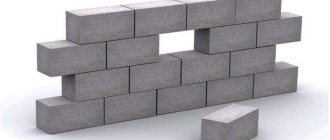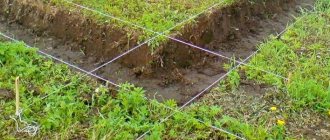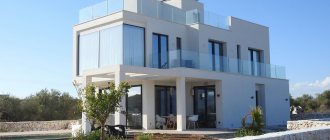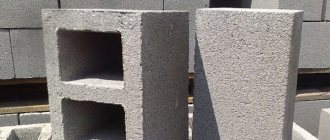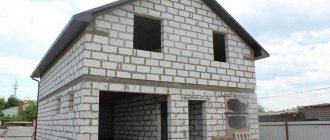Cinder blocks are often used not only in the construction of residential buildings, but also in the construction of outbuildings and cellars.
Another type of building where it is typical to use cinder blocks is a bathhouse. A sauna made from such material is always cheaper to build than if it were built from other raw materials. If you build walls yourself, then you need to know the features of this stone and the subtleties of the work technology.
Is it possible to build with this material?
In Rus', it was customary to build baths and steam rooms only from wooden material. Today, not every owner of a plot can spend a large amount of money on the purchase of a log house or timber. Therefore, instead of wood, bathhouses are sometimes built from cinder blocks. This is a lightweight, environmentally friendly and affordable material that will perfectly cope with the task required of raw materials for the construction of such premises.
When is it advisable to build a bathhouse from cinder blocks:
- if a house is being built on the site from the same material;
- if the building is small and easily erected;
- if there are not enough funds for construction;
- if there is a plan to build quickly.
For example, if there is already a cinder block house on the site or its construction is underway, then at the same time you can remove the walls for the sauna. In this case, it is more profitable for the owner to purchase or independently make a machine for making cinder blocks with a vibrating table.
You can also buy ready-made material: for bulk purchases, the manufacturer can give a discount. If a house is being built from a different material, it makes no sense to build a cinder block steam room . It is easier to build it from the same materials from which the house is made.
Important! There is one factor that frightens land owners who want to use this material. Depending on the components added to the slag mixture, the finished block may have background radiation. In this case, it will no longer be an environmentally friendly material, and it is impractical to build a sauna from it.
Which blocks are suitable and why?
In order for the steam room and bathhouse as a whole to meet the required characteristics, it is necessary to select the right blocks for construction.
There are cinder blocks of different sizes, with a tongue-and-groove connection, blind and with voids. The voidness of blocks can reach 40% . Blocks with a hollowness of 28-30% are excellent for constructing external walls of a room. Blocks of any size are suitable for this, but most often they use standard ones - 388x188x10 mm. Houses are often built from stone of these dimensions, but solid blocks are used.
For the construction of external walls, it is better to choose raw materials with voids, as they will serve as an additional heat insulator.
Due to the presence of holes, such blocks are light in weight, so laying is easy and quick . In just a couple of months of daily work you can build a box.
For laying internal walls between the shower room, toilet and steam room, it is better to use thinner partition blocks. In this way, the loss of space inside the building can be significantly reduced.
Foam block - production cost calculation
Foam blocks
Foam concrete blocks are also lightweight and affordable building materials. Of course, their cost is slightly higher than the cost of cinder blocks, but this does not make them less popular. Foam blocks have a lot of advantages: from ease of installation and environmental friendliness to water resistance and excellent thermal insulation.
Due to the properties of this material, there is always a demand for it both among construction companies and individuals, because the cost of building a house from foam blocks is quite low.
A neat foam block cottage with an attic. The cost of a house made of foam blocks is from 14,200 thousand rubles per 1 m².
But we are not talking about the construction of houses, but specifically about the production of foam blocks. Another, so to speak, small business idea. It will require no more than 300 thousand rubles to open it.
What does this amount include? Let's get a look.
- Components: cement, sand, foaming agent and water.
- Either a pressure unit or a foam generator. What is the difference? In the first case, the manufacturing technology is cheaper and simpler due to the low cost of the equipment. However, the quality of the products is also poor - the strength and environmental friendliness of foam blocks suffer significantly due to inaccurate dosage of components and the use of synthetic foaming agents.
Pressure installation for preparing foam concrete mixture. The cost of such equipment is 90 thousand rubles
The foam generator allows you to mix all the ingredients in the correct proportions, which has a positive effect on the strength and environmental friendliness of the products. But the cost of foam blocks increases due to the high cost of equipment and high-quality components.
Foam generator
Either metal cassette molds or a cutting complex for forming blocks. The first device, again, is the simplest and cheapest. The concrete mixture is simply poured into various forms and remains there until it dries completely. Then the finished products are pulled out of these molds and stored.
Form with twenty compartments. Its cost is about 30 thousand rubles.
What are the disadvantages of this method? Divergence of blocks in geometry, the likelihood of chipping during their removal from molds, the need to buy different shapes so that a large number of foam blocks of various sizes can be produced.
But the cutting complex allows you to produce many blocks of any size at once, with excellent geometry and no damage to the surface of the products. The whole point of molding comes down to pouring concrete into a large mold. Then one large block is cut into foam blocks of the required size by adjusting the pitch of the saw strings. It is very convenient, although such a device is quite expensive.
In the photo - cutting complex
And this is how smooth the foam blocks are after machine cutting
In general, there are several business options for producing foam blocks. We will focus on the simplest of them, using a pressure setting and molds.
In this case, the cost of producing foam blocks, as mentioned earlier, will not exceed 300 thousand rubles. And since foam block is a popular material in the construction market, all costs will pay off in 3-4 months.
https://youtube.com/watch?v=T7OOW3Ze3c0
Pros and cons of a cinder block steam room
Those who have already built cinder block baths note several important advantages and disadvantages of this choice. First about the pros :
- high thermal insulation properties;
- fire resistance;
- resistance to mold and mildew;
- ease of operation;
- availability of a large number of sizes;
- a light weight.
Thermal insulation is very important in a steam room, because if you make a structure from materials that do not retain heat inside the room, you will have to constantly take care of maintaining a high temperature, which will drop every now and then even with kindling.
Cinder block is a fire-resistant material, so if a fire occurs, the building will remain intact , which cannot be said about a sauna made of logs or timber. During laying, fungus will not appear on the surface of the material due to its good resistance to biocontamination.
Reference! Most builders note that there are no difficulties when working with cinder blocks. The material fits perfectly into the solution and can be corrected. The work is quick and easy. Due to its low weight, there is no need for specialized equipment.
Construction with cinder block is not without its disadvantages. Among them is high hardness, which makes it difficult to process the material when building walls. In addition, cinder block is hygroscopic, so it is important to take care of storing raw materials on the site in a place protected from rain. And after construction - about finishing.
We invite you to see a photo of a cinder block bathhouse:
Geometry
Geometry
Wall blocks are produced in the form of rectangular parallelepipeds with 90-degree or rounded edges. Special blocks are produced for the corners of the building. In addition, stones of special non-standard shapes are made to order. Thus, one can note the good geometry of the individual products and the constructed building as a whole. And even if individual blocks have deviations in size, a one and a half centimeter layer of mortar connecting the rows will level out small (up to 3 mm) errors.
In terms of geometricity, cinder block is not inferior to brick and other stone building blocks.
Video - Geometry of cinder block
Wall requirements
The walls of the bathhouse made of the specified material are subject to special requirements specified in SNiP II-L.13-62. In addition to the fact that during the design, procedures for vapor and waterproofing must be provided, when constructing walls, moisture must not penetrate into the material.
The main requirement for thickness is to ensure proper thermal conductivity of the room . To do this, you need to calculate it in advance. For the calculation, the required thermal conductivity for different regions is used: you can find it on the Internet in tables.
They also take the coefficient of thermal conductivity of the cinder block and the thickness of the block used. It must be divided by a coefficient; the resulting indicator must be greater than the parameter indicated in the table. If it is smaller, then the thickness is chosen incorrectly. Typically, a thickness of 380 mm is enough to build a bathhouse.
What is a cinder block
Advantages of slag concrete blocks
- Fire resistance. This material is a completely non-flammable material. It can withstand fairly high temperatures and does not collapse.
- Able to withstand severe mechanical loads caused, for example, by hurricane winds.
- Excellent thermal insulation and sound insulation qualities. Which saves on heating.
- Protection from insects, mold and mildew do not appear on it.
- Cinder concrete blocks are lightweight, less than concrete.
- This material is easy to work with - building a bathhouse from cinder blocks with your own hands can be done in a matter of days.
How to make a project?
To prepare a project for a future sauna, you can contact a special company, where they will develop a plan for the owner. You can also search for ready-made projects on the Internet or purchase from friends. What to consider when drawing up such a plan :
- The area of the plot, its boundaries, allocated for the construction of the sauna.
- Condition of the soil in the selected location.
- Necessary communications that will be connected to the sauna.
- How will communications be entered into the bathhouse?
- Dimensions of the building itself.
- Interior layout.
It is favorable to place a green area around the steam room: trees, bushes. To prevent the foundation from subsiding later, it is important to know the condition of the soil. To do this, samples are taken and examined. , as well as the arrangement of pits for drainage and sewerage, depend on the condition of the soil Electricity and water will be supplied to the building; all this is provided for in the project.
Note! In suburban areas, free-standing bathhouses are not made large. Often these are buildings measuring 6x4 meters and a ceiling height of 2.5-3 meters. A building built from cinder blocks will retain heat better if it is small.
It is important to immediately think about the number of rooms and their sizes - this will determine how much cinder block stone is needed for internal walls and partitions. The rooms that are most often located in a bathhouse are: steam room, locker room, waiting room, shower room, cooling area, relaxation room, toilet.
Photos of bathhouse projects of different sizes and layouts:
Internal insulation
The structure of cinder blocks is porous, which allows for excellent heat retention, but the same porous surface absorbs moisture. Therefore, maximum protection of the walls eliminates the accumulation of moisture inside the blocks.
Before insulation, the internal walls of the bathhouse are lathed with wooden slats at least 50 mm thick, on which a layer of mineral wool, basalt insulation, polystyrene foam or any other material is laid. The thermal insulation layer is covered with foil film or aluminum foil, which performs the function of waterproofing
Particular attention should be paid to the tightness of the joints of all layers
Aluminum foil is used as a material for insulating seams. If such insulation is insufficient, it is possible to lay one layer of non-combustible mineral wool between the wall and the vapor barrier layer.
What supplies and tools will be needed?
For the construction of a bathhouse you will need the following tools :
- hammer;
- order;
- level;
- lace;
- trowel;
- plumb line;
- container for mixing the solution;
- a spatula with teeth or a special container;
- electric drill with attachment.
The list shows the minimum that is needed only for the construction of walls. For foundation work, you will also need a concrete mixer, roofing material, a laser level, a water level, and a square. To equip the roof, you need the material from which the flooring will be made, as well as metal or wooden structures to create a rafter-beam system.
You also need to prepare a cinder block in the required quantity and a solution. The solution used is a cement-sand mixture , which is mixed with water in a concrete mixer or bucket using a drill.
Technology of construction and finishing of cinder block baths
A box made of cement-sand blocks turns out to be heavy enough and at the same time weak so that the bathhouse could be built on a pile or columnar foundation. Most often, a shallow shallow foundation in the form of a concrete strip is made for a building.
If, according to the project, cinder block walls have to be installed on viscous and heavily watered soil or on a terrain with a surface slope, then it is best to use a pile-strip foundation reinforced with steel or fiberglass rods for the bathhouse.
Step-by-step DIY construction instructions
When all the materials are ready and the stone has been purchased in the required quantity, you can begin work. To do this, it is recommended to follow the instructions:
Arrangement of the foundation .
The best foundation option for a cinder block bathhouse is pile or strip. Since cinder block is too hygroscopic, the foundation should raise the walls of the sauna at least 50 cm from the ground.Be sure to use waterproofing material before building walls.
To arrange a strip foundation, markings are carried out, soil is excavated, a drainage cushion is poured and compacted. Then formwork is made and concrete is poured.
- Construction of walls . After the foundation has hardened and dried, the walls are erected. Determine the highest angle and start laying from there. Initially, pull the cord and make markings. The solution is placed on the foundation itself and passed over it with a notched trowel or a special carriage. Place a block on top, leveling it slightly with a mallet.
- Construction of the roof . First, they make ceiling beams from timber, then attach the rafters. It is better to assemble the system on the ground, then lift it up. At the final stage, the sheathing is done and the roofing material is laid.
At the last stage, external and internal finishing is performed. After this, the bathhouse can be equipped from the inside.
Laying the foundation
Shallow strip foundation
The type of foundation for a bathhouse is selected after examining the soil on the site. When laying the foundation for a building on clay or peat soil, you will need a columnar or strip foundation and good waterproofing. A dense rocky area does not need a foundation for a lightweight cinder block building.
The first stage of laying the foundation is marking the selected area and preparing for its work. When installing a strip foundation, a shallow trench is dug along the entire perimeter of the walls of the building. The depth of the pit is 50 cm, width - 40 cm. Then formwork is made, the manufacture of which can be read here.
The hole needs to be filled with sand
Sand and gravel are poured into the bottom of the trench and carefully compacted to create a cushion. Stones or broken bricks are laid on it. Formwork made of boards is placed on top. Due to the high hygroscopicity of cinder block, it is necessary to raise the foundation to 50 cm above ground level. Concrete is poured into the removable formwork and covered with a film for several days to prevent moisture loss.
When laying the foundation of the building, they simultaneously lay the foundation for the stove. It is performed by analogy with the common foundation, but does not come into contact with it.
Do you need insulation inside and outside?
It is necessary to insulate a cinder block bathhouse both from the inside and from the outside. If in residential buildings made of such material there is no need for internal thermal insulation, then such a procedure cannot be avoided. External insulation occurs at the stage of wall finishing .
To do this, create a sheathing on the facade. Thermal insulation material is inserted into the frame and then sewn up with finishing materials. Before making the frame, be sure to lay waterproofing in rolls along the outside of the wall.
Insulation of a bathhouse from the outside:
Internal insulation is done according to a different principle . Here you first need to install waterproofing, then make lathing, and then use a vapor barrier. After this, apply insulation and finishing interior trim.
Mineral basalt wool is used for internal thermal insulation. Inside the steam room you need to arrange a “thermos” from foil material, then sew it up with trim.
Internal thermal insulation:
Heated floor installation
Laying and securing an electric heated floor to a grid
We carry out the work in the following order:
- To facilitate the installation of electrical heating systems, a fiberglass reinforcing mesh with a cell size of 50x50 mm is laid on the vapor barrier material. We lay the mesh with a slight overlap and tie it together.
- We lay out the electric cable for heating on the floor in a “snail” or “snake”. We fix it to the grid.
- Then we install a warm floor sensor in the wall.
- We connect and connect all components of the system.
- After checking that the device is working properly, you can begin pouring the screed.
Possible difficulties and errors in the process
When building a cinder block bathhouse, difficulties and errors may arise. Some of them:
- low-quality cinder block;
- use of a monolithic foundation;
- errors in calculating wall thickness;
- lack of thermal insulation;
- lack of waterproofing;
- incorrectly prepared masonry mortar.
When purchasing a cinder block, you should ask the manufacturer about the availability of certificates for the quality of the product. Low cost may indicate a high percentage of defective building materials . There may also be the following errors:
- If you incorrectly calculate the thickness of the blocks and their dimensions, then excessive load on the floor can cause the foundation to shrink.
- If you do not waterproof and install insulation, the cinder block will accumulate moisture.
- If the masonry mortar is prepared incorrectly, cracks may form on the surface of the masonry.
Results
On the market of materials offered for construction, sand block is a profitable raw material for realizing your plans. The properties of the material provide an expanded scope of application. It is used in the construction of residential and non-residential premises, low-rise buildings, and with thickened masonry - even multi-storey buildings. By giving it preference, you will reduce costs and quickly build the planned facility.
3/5 (2 votes)
Filontsev Viktor Nikolaevich
On the website: Author and editor of articles on the website pobetony.ru Education and work experience: Higher technical education. 12 years of experience in various industries and construction sites, 8 of which were abroad. Other skills and abilities: Has the 4th group of electrical safety clearance. Perform calculations using large data sets. Current employment: For the last 4 years he has been acting as an independent consultant for a number of construction companies.
Cost of work: what does the price depend on?
If it is not possible to build a sauna from a cinder block with your own hands, then you can use the services of contractors. The cost of the work will depend on several factors :
- project complexity;
- type of foundation;
- size of the building;
- construction region.
Average prices for the service in Russia range from 150,000 to 360,000 rubles per object.
Furnace laying
There are a large number of sauna stoves on the modern market, with heaters, fireboxes and water tanks.
It is worth considering that it is quite problematic to build stone stoves yourself without the proper experience and skill. Metal furnaces can be ordered from forges and specialized and specialized workshops. Fans of classic brick and metal stoves should take into account that special autonomous foundations with a depth of more than 500 mm and dimensions that are 10% larger than the dimensions of the stove itself are poured under such stoves.
Installation of modern type stoves is possible after completion of interior decoration. Old-style stoves were built before the interior finishing work was completed.
For more details, read the article Brick sauna stove.
Beautiful examples
Many consumers are skeptical about block baths, explaining this by their unsightly design. In fact, such buildings can be made very stylish and attractive not only inside, but also outside.
For example, a small building with a triangular roof and steps leading to a dressing room can be finished with light-colored siding panels. The lower part of the building should be lined with decorative brown bricks around the perimeter. In such a bathhouse, blue or purple tiles will stand out effectively.
At the entrance to the building, place brick columns and install a red tile roof on top, which would cover the entire structure as a whole (along with the terrace). Green plants and flowers should be planted around. As a result, you will get a very impressive bathhouse.
A bathhouse made of blocks can be made laconic, but no less attractive, by playing on the contrast of the walls and roof. For example, the external finishing of block ceilings should be done with snow-white or beige plaster/paint, and brown coverings should be chosen for the roof. Install high plastic windows and doors in such a structure. This will make the bathhouse more stylish and modern.
You will learn more about an aerated concrete bathhouse and its features from the following video.


